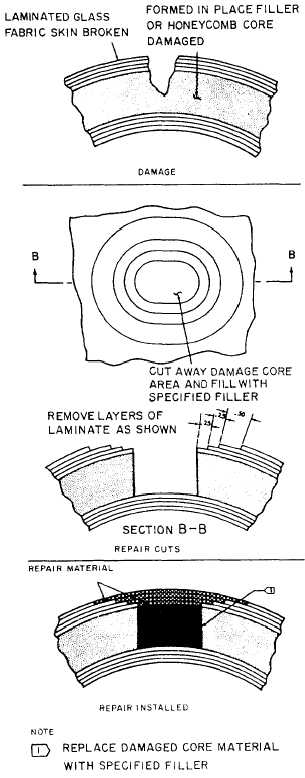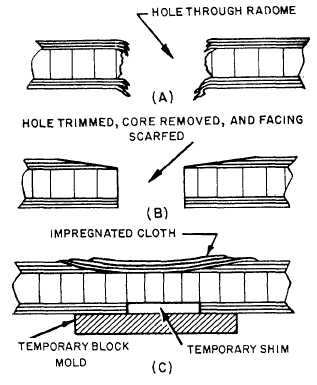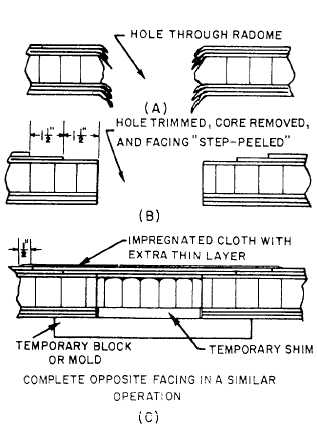|
HONEYCOMB CORE. Repairs
to damages completely through
the sandwich structure may be accomplished
either by the scarfed method (similar to the
repair described for damage extending into the core)
or the stepped method.

Figure 14-12.Foam-type core
repair.
The scarfed method is normally used on small punctures
up to 3 or 4 inches in maximum dimension and
in facings made of thin cloths (which are difficult to
peel). The stepped method is usually employed on larger
repairs to facings composed of thick cloths. The
scarfed method of repair for punctures is the same
as that used for damage extending into the core, with
the exception that the opposite side of the sandwich
is provided with a temporary mold or block to
hold the core in place during the first step. See view
C in figure 14-13.
After the first facing repair is cured completely, the
mold and the shim (temporarily replacing the facing
on the opposite side) are removed. The repair is
then completed by repeating the procedure used in the
first step. When this facing is cured, the surface should
be sanded down to the original contour and the repair
area lightly sanded in preparation for refinishing.
When you use the stepped method of repair, the damaged
area is first trimmed out to a round or oval shape
or to a rectangular or square shape (preferably having
rounded corners).

Figure 14-13.Scarfed repair
method.
The individual plies are then cut
out as shown in figure 14-14. Each
ply is "stepped" back 1 1/2 inches and
trimmed out by using a sharp knife. The sides of the
repair should be parallel with the weave of the cloth,
if possible.
NOTE: Do not cut through
more than one layer of cloth. If
the layer of cloth underneath is
scratched, the strength of the repair will suffer.
The opposite facing is shimmed and backed up with
a mold, and the core material is inserted as previously
described. The outer repair plies are soaked
in the resin and laid over the damaged area. An
extra layer of thin cloth is laid over the repair area to
extend one-half inch over the undamaged facing. The
repair area is then covered with a sheet of cellophane
to apply pressure, and then it is allowed to cure.
The inner facing is then replaced in the same manner
as the outer facing. After the inner repair has been
cured, the entire repair area should be sanded to the
original contour and prepared for refinishing.
FOAM CORE. When the
puncture penetrates the entire
wall, remove the damaged core and face

Figure 14-14.Stepped repair
method.
laminates to one-fourth inch past the perimeter of the hole
on the inner face. Make a plaster support to replace
the removed core, conforming to the curvature
of the inside layer of the inner face. Figure
14-15 shows a punctured repair with a plaster support.
After repair to the inner face has been completed, remove
the plaster support and continue the repair on the
opposite side.
|

